If you take a stroll along freshly harvested rice fields, you are likely to come across flowering Sauropus plants.
These are large bushes with long, drooping branches. The leaves are simple, alternate, oval, varying in hardness, and terminate in a point. The small yellow flowers are clustered in groups of two or three, hanging beneath the leaves, with both male and female flowers on the same plant. The fruit is a capsule of a few millimeters, rather woody, bearing traces of the calyx.
In Laos, the locals call this plant phak van ban or phak van xang, indicating that they consider it a vegetable (phak). However, we haven’t seen it in markets, although we are told it is cultivated. It is often found in its natural state on the edges of forests in Laos and also from India to Vietnam and southern China. It seems that in our region, phak van ban is primarily a food source during scarcity when other vegetables are lacking. People then consume the young shoots raw or cooked with other plants.
If phak van ban is harvested, it is more likely for its medicinal properties: a decoction of the roots is said to relieve urinary pain and reduce fever. In Yunnan, young mothers are given a soup made from the leaves to promote lactation, and it is believed that this beverage is also a good tonic for women who have just given birth.
Si vous vous promenez au bord des rizières fraîchement moissonnées vous avez toutes les chances de voir des Sauropus en fleurs.
Ce sont de grands buissons aux longs rameaux pendants. Les feuilles sont simples, alternes, ovales, plus ou moins dures, terminées par une pointe. Les petites fleurs jaunes sont par grappes de deux ou trois suspendues sous les feuilles, les mâles et femelles sur le même pied. Le fruit est une capsule de quelques millimètres, plutôt ligneuse, portant les traces du calice.
Les Lao nomment cette plante phak van ban, ou phak van xang, c’est dire qu’ils la considèrent comme un légume (phak). Cependant nous n’en n’avons pas vu sur les marchés bien que, nous dit-on, il soit cultivé. On le rencontre souvent à l’état naturel en bordure des forêts au Laos et aussi depuis l’Inde jusqu’au Vietnam et le sud de la Chine. Il semble donc que dans notre région phak van ban soit surtout un aliment de disette, que l’on ramasse quand les autres légumes font défaut. On mange alors les jeunes pousses crues ou cuites avec d’autres plantes.
Si phak van ban est ramassé c’est plutôt pour ses propriétés médicinales: une décoction des racines soulagerait les douleurs urinaires et ferait baisser la fièvre. Au Yunnan on donne aux jeunes mères une soupe des feuilles pour faire monter le lait et l’on pense que ce breuvage est aussi un bon reconstituant pour la femme qui vient d’accoucher.
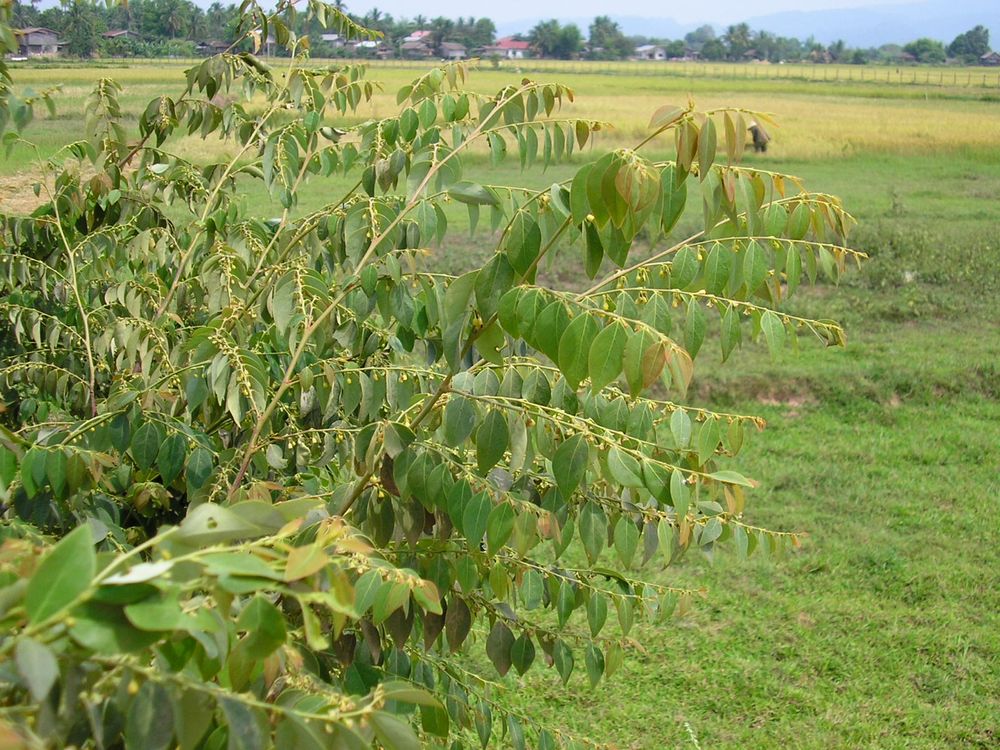
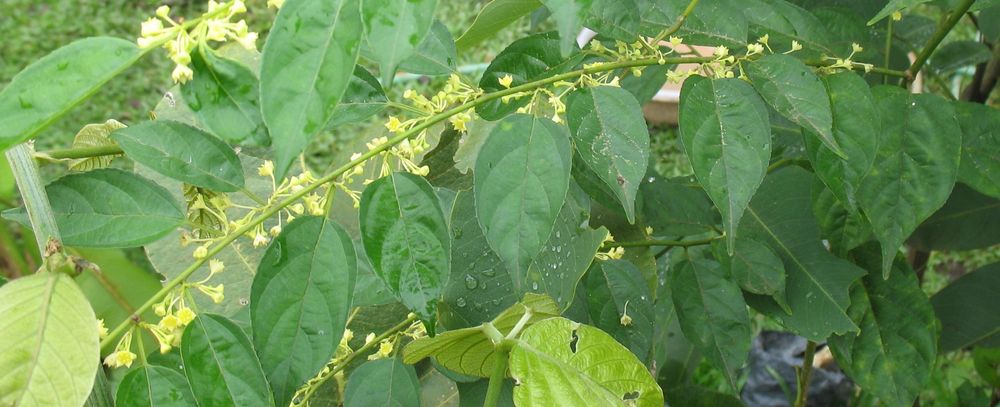
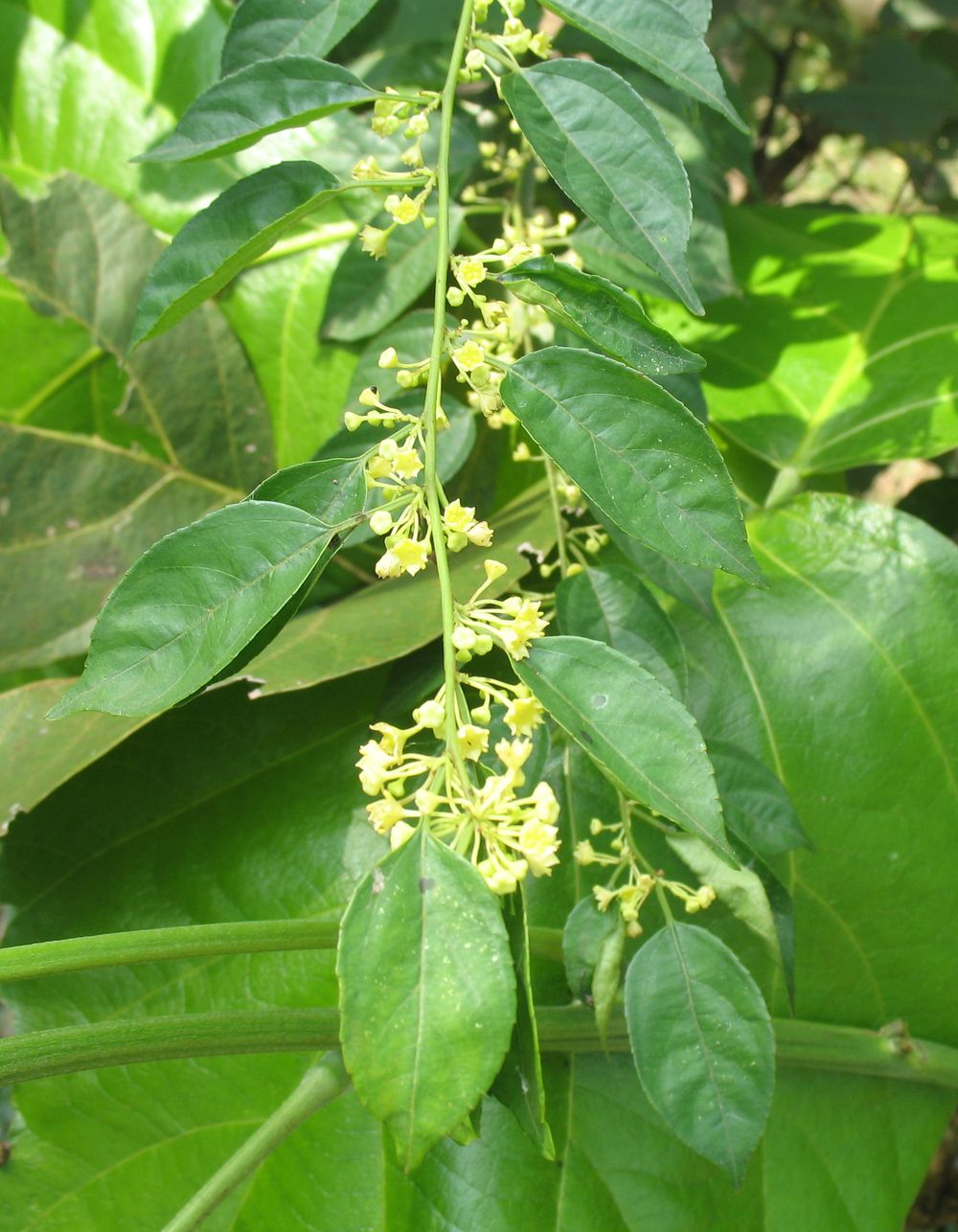
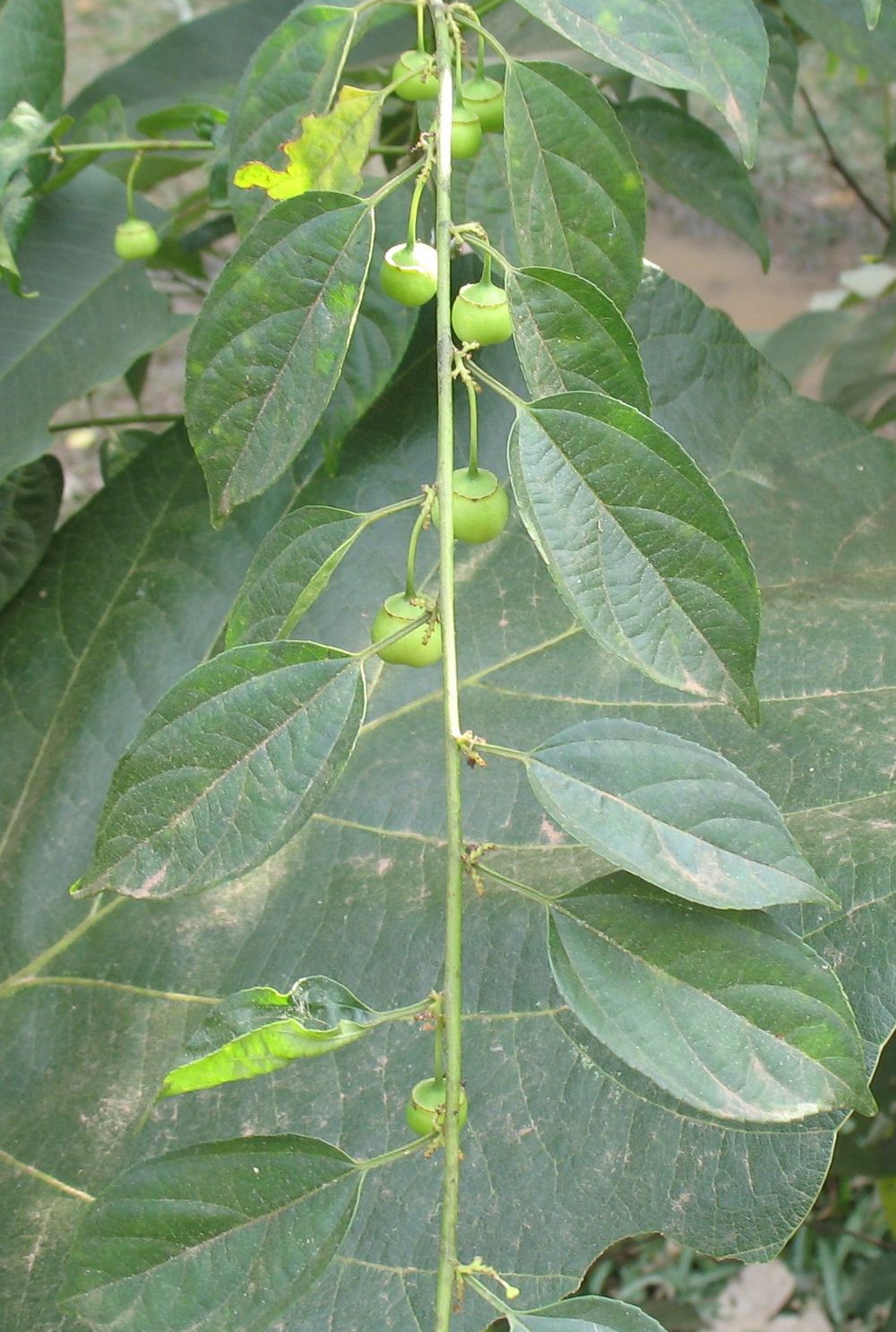
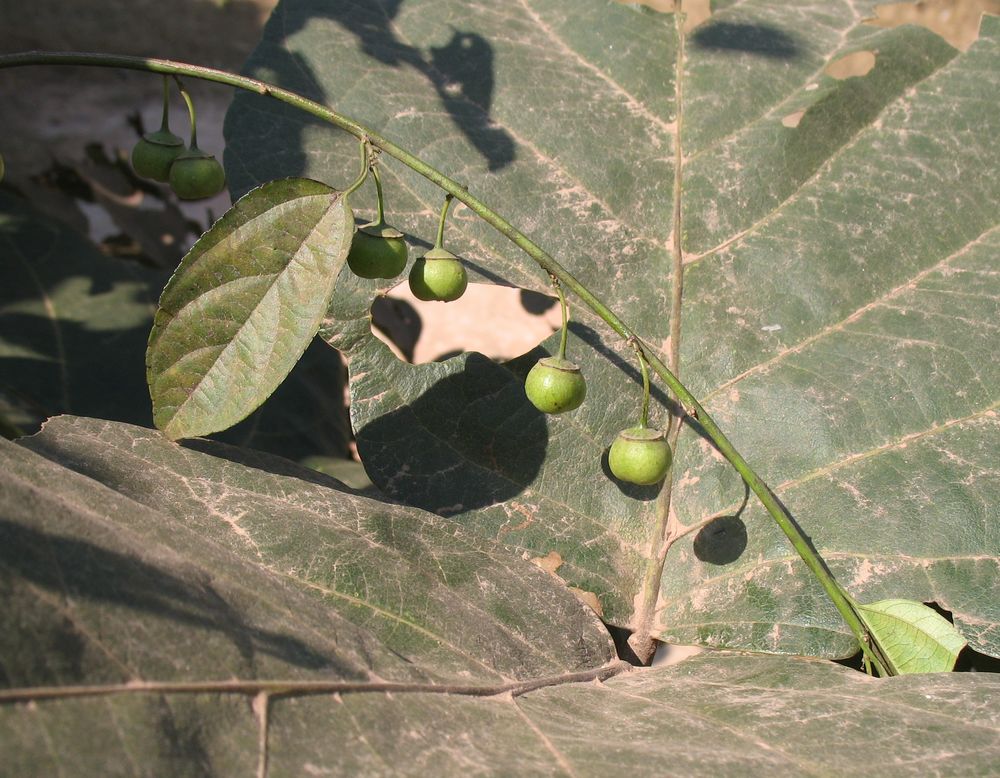
If you take a stroll along freshly harvested rice fields, you are likely to come across flowering Sauropus plants.
These are large bushes with long, drooping branches. The leaves are simple, alternate, oval, varying in hardness, and terminate in a point. The small yellow flowers are clustered in groups of two or three, hanging beneath the leaves, with both male and female flowers on the same plant. The fruit is a capsule of a few millimeters, rather woody, bearing traces of the calyx.
In Laos, the locals call this plant phak van ban or phak van xang, indicating that they consider it a vegetable (phak). However, we haven’t seen it in markets, although we are told it is cultivated. It is often found in its natural state on the edges of forests in Laos and also from India to Vietnam and southern China. It seems that in our region, phak van ban is primarily a food source during scarcity when other vegetables are lacking. People then consume the young shoots raw or cooked with other plants.
If phak van ban is harvested, it is more likely for its medicinal properties: a decoction of the roots is said to relieve urinary pain and reduce fever. In Yunnan, young mothers are given a soup made from the leaves to promote lactation, and it is believed that this beverage is also a good tonic for women who have just given birth.
Si vous vous promenez au bord des rizières fraîchement moissonnées vous avez toutes les chances de voir des Sauropus en fleurs.
Ce sont de grands buissons aux longs rameaux pendants. Les feuilles sont simples, alternes, ovales, plus ou moins dures, terminées par une pointe. Les petites fleurs jaunes sont par grappes de deux ou trois suspendues sous les feuilles, les mâles et femelles sur le même pied. Le fruit est une capsule de quelques millimètres, plutôt ligneuse, portant les traces du calice.
Les Lao nomment cette plante phak van ban, ou phak van xang, c’est dire qu’ils la considèrent comme un légume (phak). Cependant nous n’en n’avons pas vu sur les marchés bien que, nous dit-on, il soit cultivé. On le rencontre souvent à l’état naturel en bordure des forêts au Laos et aussi depuis l’Inde jusqu’au Vietnam et le sud de la Chine. Il semble donc que dans notre région phak van ban soit surtout un aliment de disette, que l’on ramasse quand les autres légumes font défaut. On mange alors les jeunes pousses crues ou cuites avec d’autres plantes.
Si phak van ban est ramassé c’est plutôt pour ses propriétés médicinales: une décoction des racines soulagerait les douleurs urinaires et ferait baisser la fièvre. Au Yunnan on donne aux jeunes mères une soupe des feuilles pour faire monter le lait et l’on pense que ce breuvage est aussi un bon reconstituant pour la femme qui vient d’accoucher.










If you take a stroll along freshly harvested rice fields, you are likely to come across flowering Sauropus plants.
These are large bushes with long, drooping branches. The leaves are simple, alternate, oval, varying in hardness, and terminate in a point. The small yellow flowers are clustered in groups of two or three, hanging beneath the leaves, with both male and female flowers on the same plant. The fruit is a capsule of a few millimeters, rather woody, bearing traces of the calyx.
In Laos, the locals call this plant phak van ban or phak van xang, indicating that they consider it a vegetable (phak). However, we haven’t seen it in markets, although we are told it is cultivated. It is often found in its natural state on the edges of forests in Laos and also from India to Vietnam and southern China. It seems that in our region, phak van ban is primarily a food source during scarcity when other vegetables are lacking. People then consume the young shoots raw or cooked with other plants.
If phak van ban is harvested, it is more likely for its medicinal properties: a decoction of the roots is said to relieve urinary pain and reduce fever. In Yunnan, young mothers are given a soup made from the leaves to promote lactation, and it is believed that this beverage is also a good tonic for women who have just given birth.
Si vous vous promenez au bord des rizières fraîchement moissonnées vous avez toutes les chances de voir des Sauropus en fleurs.
Ce sont de grands buissons aux longs rameaux pendants. Les feuilles sont simples, alternes, ovales, plus ou moins dures, terminées par une pointe. Les petites fleurs jaunes sont par grappes de deux ou trois suspendues sous les feuilles, les mâles et femelles sur le même pied. Le fruit est une capsule de quelques millimètres, plutôt ligneuse, portant les traces du calice.
Les Lao nomment cette plante phak van ban, ou phak van xang, c’est dire qu’ils la considèrent comme un légume (phak). Cependant nous n’en n’avons pas vu sur les marchés bien que, nous dit-on, il soit cultivé. On le rencontre souvent à l’état naturel en bordure des forêts au Laos et aussi depuis l’Inde jusqu’au Vietnam et le sud de la Chine. Il semble donc que dans notre région phak van ban soit surtout un aliment de disette, que l’on ramasse quand les autres légumes font défaut. On mange alors les jeunes pousses crues ou cuites avec d’autres plantes.
Si phak van ban est ramassé c’est plutôt pour ses propriétés médicinales: une décoction des racines soulagerait les douleurs urinaires et ferait baisser la fièvre. Au Yunnan on donne aux jeunes mères une soupe des feuilles pour faire monter le lait et l’on pense que ce breuvage est aussi un bon reconstituant pour la femme qui vient d’accoucher.


